Realizing Returns on IoT Investments Across Field Service Environments
How IoT applications drive value in operations, analytics, business decision making, customer experiences, and more
A 2018 Field Service Report

Introduction
In 2018, Field Service organizations have matured beyond speculating about the possibilities of Internet of Things (IoT). They are driving real results in multiple channels of their business. In fact, 42% of field service organizations have already incorporated IoT and 31% plan to do so within 24 months strictly to improve customer satisfaction and loyalty, let alone other initiatives.
But while critical to transforming field service, experts acknowledge that IoT is not a ‘plug and play’ technology. The types of devices that function as part of an IoT environment are increasing, along with the ways in which data can be applied for derivations and analysis. Organizations question how they can achieve an ideal environment in which they can transform the entirety of business with better, more optimized IoT solutions.
In this report, Field Service partnered with the WBR Insights research team and benchmarked organizations’ successful applications of IoT to drive true business value. The report introduces a quantitative analysis of maturity and ROI in business areas like data analytics, process quality, service performance, and profit.
Additionally, researchers received direct commentary from industry leaders about their experiences with the technology and their IoT goals for the future. That includes future plans for those companies yet to realize their own IoT success.
Key insights from the research include:
83%
of organizations using connected data and IoT to create advanced services believe it leads to more profitable business decisions
79%
of organizations are using IoT data analytics to establish product or process quality imperatives.
37%
of organizations plan to incorporate IoT with service processes within 24 months. This is the most popular business function in terms of two-year planning for IoT adoption.
MORE
companies have already incorporated IoT for customer satisfaction and loyalty than for any other business function measured in the study.
37%
of respondents—a plurality—believe driving business performance by integrating IoT with next-gen technologies such as AI or machine learning is the top advantage of IoT.
About the Study
Respondents to the survey come from a variety of verticals and roles. All of them hold leadership positions, and all speak with authority on the IoT plans and investments of their organizations.
20% of companies provide services in the medical and scientific devices space, a plurality among all service spaces measured. Half of the remaining companies provide services in the construction and industrial (17%), manufacturing (12%), and utilities (11%) spaces.
In each case, less than 10% of companies service transportation (8%), commercial computers (7%), semiconductors (6%), enterprise network equipment (6%), appliances and electronics (5%), and domestic computers (4%). Four percent of companies provide services in other areas.
What best describes the areas in which you provide service?

51% of the companies surveyed are enterprise companies with over $500 million in annual revenue. Seventeen percent are mid-market What is your organization's estimated annual revenue? companies with $100 million to $500 million in annual revenue. All other companies (32%) are small- to mid-sized companies with less than $100 million in annual revenue.
IoT and Product Optimization
An analysis of the three business segments shows that enterprise companies are the most likely to have incorporated IoT for product optimization. SMBs are more likely to have done so than mid-market companies, but almost 50% of mid- market companies plan to do so within the next 24 months.
What is your organization's estimated annual revenue?
51%
>$500 million (Enterprise)
17%
$100 million — $500 million (Mid-Market)
32%
<$100 million (SMB)
Companies are well-represented by respondents at all levels of management. 29% of respondents are C-Suite executives (6%), vice presidents (11%), or department heads (12%). Most other respondents are directors (40%), and 31% are managers.
What is your role?
51%
C-Suite
11%
Vice President
12%
Department Head
40%
Director
31%
Manager
With Alliance Enterprise & IoT, predictive service becomes a reality.
Some of the world’s best service companies are using Astea’s integrated FSM and IoT solution to empower their customers. They’ve found that providing predictive service comes more from knowing what to do with the data you’re collecting than it does from simply collecting it. That’s the power of Astea’s FSM platform, Alliance Enterprise.
No FSM platform delivers embedded business intelligence like Alliance Enterprise does. With Alliance, you’ll do more than just collect data – you’ll become a valued partner by enabling your customers to make better business decisions.
To take the first step towards offering the predictive service your customers demand, contact Astea today.
www.astea.com | 1.800.878.4657
Taking a Business Approach to IoT Adoption
Adopting IoT as part of the greater service and business environment involves keeping up with industry changes as they take place. That means Are you using IoT data analytics to establish product and/or process quality imperatives? incorporating better measures when needs arise in any business area, and keeping cost-effective solutions in mind for future progress of the company as a whole.
Already, 76% of companies are using IoT data analytics to establish product and/or process quality imperatives. Their decision makers can analyze IoT data to improve solution recommendations, feedback on installations, demonstrations, specific services, and others. IoT also serves as a signifier for opportunities to improve more processes, such as identifying popular products and managing inventory.
Respondents believe data should be usable in decision making at a variety of business levels. In every case, a majority of companies have either adopted IoT for specific business functions or plan to do so in the next 24 months. But companies prioritize customer-facing initiatives—service, products, and satisfaction—over internal functions such as business projections and aligning service data with financials.
Are you using IoT data analytics to establish product and/or process quality imperatives?

Which business functions have you incorporated or do you intend to incorporate with IoT?

Customer Satisfaction & Loyalty
73% of companies have incorporated IoT (42%) or plan to do so within 24 months (31%) for the purpose of customer satisfaction and loyalty. More companies have incorporated IoT for this purpose than for any other measured in the study.
With connected data, companies are able to understand and fulfill customer demands better thanks to improved communication. In this way, minor technological improvements can be made without delay or other consequences.

Service Processes & Optimization
Respondents agree that connected data and IoT have helped streamline processes across departments. By leveraging IoT data, they can measure efforts for overall growth through set channels, be they internal or service-driven.
Now, 41% of companies have incorporated IoT for process optimization, a close second to customer satisfaction and loyalty. Thirty-six percent have already incorporated IoT with service processes; more companies plan to do so within 24 months (37%) than with any other business function measured.
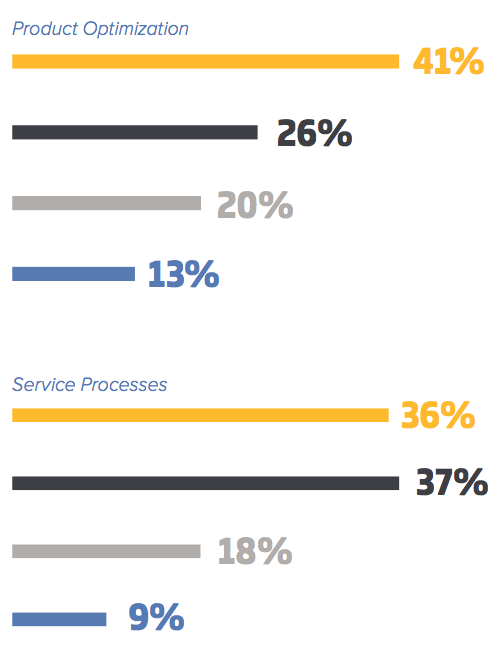
Streamline your service delivery process and avoid unnecessary service calls
Connecting the world from the inside out
Product Uptime
Companies’ attention to customer experiences carries over to product support, where one respondent cites “notable improvements” to uptime in both industrial and consumer-driven channels. One healthcare executive says IoT helps them sustain products “during times of higher demands, especially due to the fact that these are used during medical procedures.”
More than one third of companies have incorporated IoT for product uptime (34%); more than one quarter of companies have plans to incorporate IoT with product uptime (30%) within 24 months.
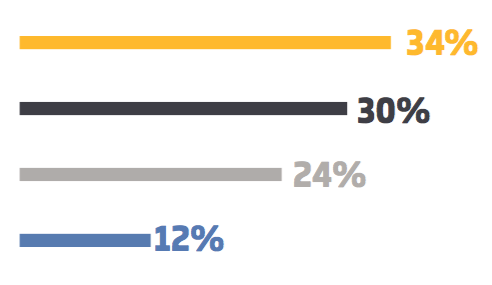
Business Projections & Decisions
IoT data can be applied to various business requirements and provide essential statistics to support managerial functions. Derivations from reliable signals allow for better judgements when making business projections and decisions.
Over one third of companies have incorporated IoT for business projections and decisions (35%); more than one quarter of companies have plans to incorporate IoT with business projections and decisions (27%) within 24 months. According to one respondent:
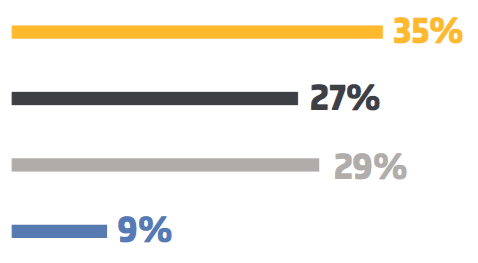
"For IoT data analysis, we make sure the derived data... is used to its full potential in order to gain maximum value. This is done by careful consideration of methods that are suited for business needs overall. Calculations and extensive research analysis has proved to be useful for various decision making streams in companies."
Predictive Maintenance
Respondents’ ambitions for better response to maintenance needs extends to real-time automated reporting, a better understanding of their products’ “general maintenance structure,” and even signals for customers to be proactive—to seek out maintenance themselves.
Several respondents cite their use of predictive reporting for scheduling, sustainability, and research methods, among others. Only 32% of companies have leveraged IoT for predictive maintenance; however, 29% plan to do so within 24 months. One respondent describes the unique predictive maintenance solutions his or her team is creating:

"We’re devising products that are enabled with advanced features such as predictive maintenance, which is basically self-thinking cleaning equipment. With the help of formulated data available from surroundings and historic information, it determines cleaning needs, thus eliminating the requirement for manual scrutiny."
Aligning Service Data with Financials
Fewer companies have incorporated IoT to align service data with financials (26%) than any other business function in the study. But the data suggests this is a growth area. More companies (61%) are either planning to incorporate IoT in this way within 24 months or are interested in incorporating IoT in this way than with any other business function.
Despite prioritization of functions that drive customer success, it is in business projections, business decisions, and aligning service data with financials that companies take an increasing interest in incorporating IoT. At least one quarter of companies have already incorporated IoT for each of these purposes.
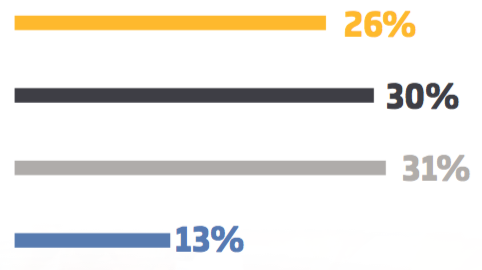
Next-Generation Challenges & Business Applications
As customer demands evolve, IoT data analytics must adapt to provide the speed of execution required by managerial functions and decisions. Now, the majority of field service companies are developing methods to make IoT-related services Are you using connected data and IoT to create advanced services? more efficient. Growth patterns suggest that they are being well received by customers as they use connected data to created advanced solutions.
Today, 75% of companies are using connected data and IoT to create advanced services; among them, 83% believe connected data and IoT lead to more profitable business decisions. Business decision makers who responded to the survey have identified several emerging applications of connected data where they are planning changes or are already seeing business results— security, product sustainability, new product technologies, and fleet management, among others.
Are you using connected data and IoT to create advanced services?
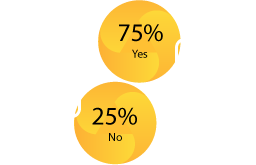
Since you are using connected data and IoT to create advanced services, do you think connected data and IoT leads to more profitable business decisions?
IFS EXECUTIVE SUMMARY

IFS STUDY: 30% OF INDUSTRIAL COMPANIES ALREADY USING IOT FOR FIELD SERVICE AND EQUIPMENT HEALTH
IFS, the global enterprise applications company, has published a study on how digital transformation and the Internet of Things (IoT) intersect for industrial companies. The study of 200 North American industrial executives with responsibility for IoT suggests that usage of data from connected devices for aftermarket field service is more widespread than many anticipated.
The study included questions targeting industrial IoT decision makers at industrial companies about the degree of sophistication of their IoT programs. The study also explores how well their enterprise resource planning (ERP), enterprise asset management (EAM) or field service management (FSM) software prepared them for digital transformation and to use IoT data.
When asked about how IoT data was used in their business, 30 percent of respondents indicated that they used it for FSM. However, only 22 percent collected IoT data from network devices carried by field service technicians or service vehicles, suggesting a disconnect between IoT used for things like condition-based maintenance and diagnostics and provision of service.

IFS Chief Technology Officer for North America Rick Veague said, “The fact that 30 percent of respondents overall are using IoT for aftermarket service is remarkable, even though the sample was heavily focused on equipment manufacturers and contractors with an aftermarket service component. We are obviously past the inflection point with this technology.”
Steve Andrew, IFS Vice President of Marketing for North America added, “This data shows that field service organizations are making heavy use of IoT data for things like condition-based maintenance. The next step for these organizations will be to use IoT data to create a competitive advantage by improving the customer experience, increasing revenues by creating new aftermarket service offerings and reducing cost of service provision. IoT-enabled FSM software will be more and more essential for any service organization committed to top line growth. But this will require a more thorough integration of IoT data with field service management software.”
Andrew is right—few respondents had the integration between IoT and enterprise software or FSM software to make the most of IoT data. Only 16 percent of respondents consume IoT data in ERP software. That means 84 percent of industrial companies face a disconnect between data from connected devices and strategic decision making and operations, limiting the digital transformation potential of IoT.
FOR MORE INFORMATION, DOWNLOAD THE STUDY “INDUSTRIAL INTERNET OF THINGS (IIOT) AND DIGITAL TRANSFORMATION.” OR VISIT IFSworld.com.
Advanced Services in Practice
“We are using connected data and IoT on an extensive level, with client dealings and remote problem solving with our advanced Affiliates Suite service to support client demands more efficiently. Under this service, we monitor data, alert clients about threats, and [provide] critical observation. With real-time data, threats can be diffused with faster diagnostics.”
“Recently, we have integrated IoT... in order for vital health information to be passed on directly to those maintaining [the equipment]. With this innovation, the availability of details in timely manner is ensured, thus speeding treatment and dispensing medication. This solution will be subject to technological advancements from time to time with upgraded systems.”
“Once we derive information such as purchase patterns, market trends, [and] competitor stats, [connected data and IoT] is used to develop substantial products that are able to withstand and supply changing mechanisms. Advanced solutions using connected data and the latest upgrades benefit customers and organization alike.”
In terms of driving business, integrating IoT with next-generation technologies appears to be the next step. When asked to choose only one top advantage of IoT, 37% of respondents Which of the following do you consider the top advantage of IoT—whether you’ve implemented an IoT solution or not? identify driving business performance by integrated IoT with next-gen technologies such as AI and Machine Learning.
This plurality is 9% higher than the second most popular choice—building customer trust with advanced services and improved uptime, speed, and/or yield—which reinforces our customer satisfaction and loyalty metric earlier in the report.
Nineteen percent of companies feel IoT should align with profit. These companies believe enabling more profitable business decisions by connecting industrial IoT to executive metrics is its top advantage, though it is arguably among the advantages of all applications.
Finally, 16% of companies believe improving product and/or process quality by establishing imperatives with IoT data analytics is the top advantage IoT. Despite respondents highlighting these as advantages earlier in the report, most may consider these a means to their primary objectives.
Which of the following do you consider the top advantage of IoT—whether you’ve implemented an IoT solution or not?
Conclusion
Companies of all sizes report positive feedback in connection with IoT-integrated products and processes, both internally and externally. Their success is inspiring plans to identify and include more such features, then incorporate them for both end-users and business development initiatives.
Successful IoT applications and the evidence for their business value are opening doors for even more impressive ideas, solutions, and applications. For many companies, that means complete integration, where connected data flows from all business touchpoints—be they signals about customer satisfaction or about data security.
Those integrations aligned with business performance will include next-generation technologies, such as AI and machine learning. Connecting IoT data flows with these technologies will deliver huge advantages to first adopters, even as other companies prioritize their future adoption. With the greater business in mind, IoT functions may become a standard, supporting business goals with its practical applications well into the future.
About the Authors

Field Service is your one-stop shop for all things service and support; an event where inspiration meets innovation; socializing meets ROI. Experience tons of sessions, interactive learning, guest speakers, and keynotes. Whatever your pain point, we’ve got you covered. Our topics cover every area impacting your business—service revenue, preventative services, connected devices and IoT, customer experience, remote diagnostics, global service, parts management, knowledge management, training and development, workforce management, mobility, help desk support, and a lot more.
Learn more at http://fieldserviceusa.wbresearch.com

WBR Insights is the custom research division of WBR (Worldwide Business Research), the world leader in B2B focused conferences. From research-based whitepapers to benchmarking reports, infographics and webinars, our mission is to help global institutions across a variety of industries to inform and educate their key stakeholders while achieving their strategic goals.
Learn more at www.wbrinsights.com
About Our Sponsors

Telit (AIM: TCM), is a global leader in Internet of Things (IoT) enablement, with an extensive portfolio of wireless connectivity modules, platforms, virtual cellular IoT operator services, and professional services, empowering hundreds of millions of connected ‘things’ to date, and trusted by thousands of direct and indirect customers, globally. With nearly two decades of IoT innovation experience, Telit continues to redefine the boundaries of digital business, by delivering secure, integrated end-to-end IoT solutions for many of the world’s largest brands, including enterprises, OEMs, system integrators and service providers across all industries, enabling their pursuit of enterprise digital transformation.
Learn more at www.telit.com

Astea International is a global leader in field service and mobile workforce management, including all the cornerstones of full service lifecycle management: customer management, service management, asset management, forward and reverse logistics management and mobile workforce management and optimization. Astea technology helps the world’s best service-driven companies generate higher profit while properly balancing customer satisfaction and service levels through proactive communication that creates a seamless, consistent and highly personalized experience at every customer relationship touch point. Astea’s solutions unify processes, people, parts, and information to focus the entire organization on the creation of sustainable value in highly competitive, global markets.
Learn more at: http://www.astea.com

IFS develops and delivers enterprise software for customers around the world who manufacture and distribute goods, maintain assets, and manage service- focused operations. The industry expertise of our people and solutions, together with commitment to our customers, has made us a recognized leader and the most recommended supplier in our sector. Our team of 3,500 employees supports more than 10,000 customers worldwide from a network of local offices and through our growing ecosystem of partners.
For more information, visit: IFSworld.com

